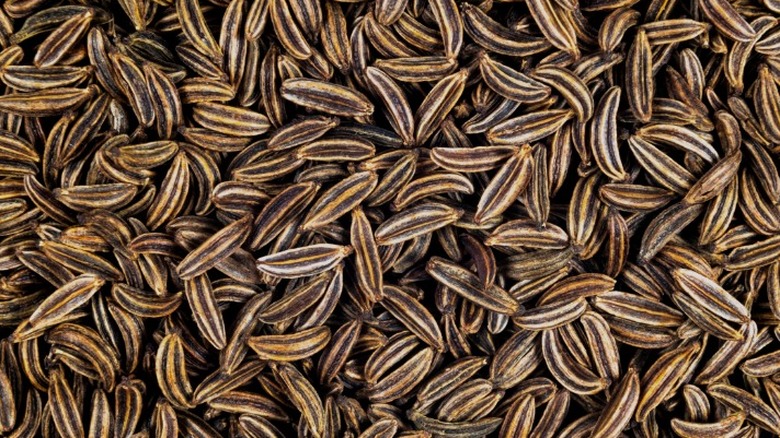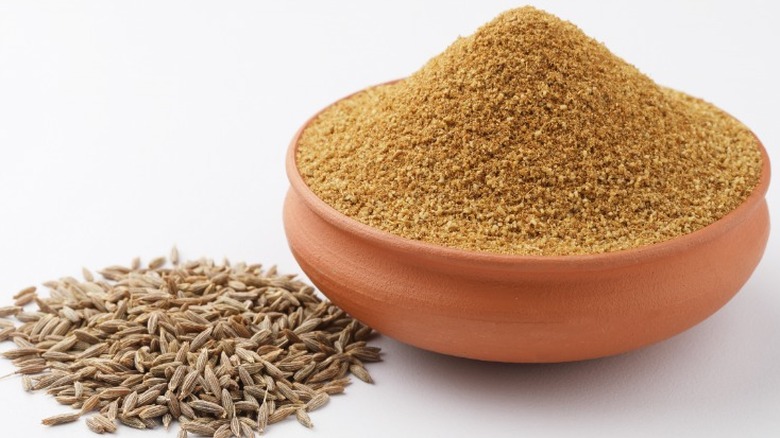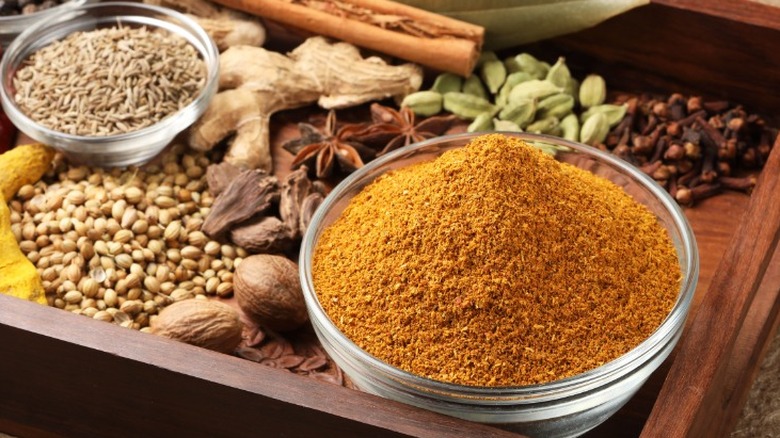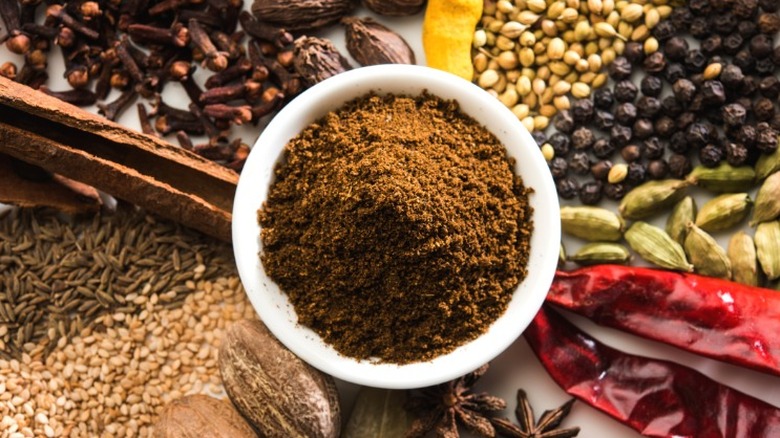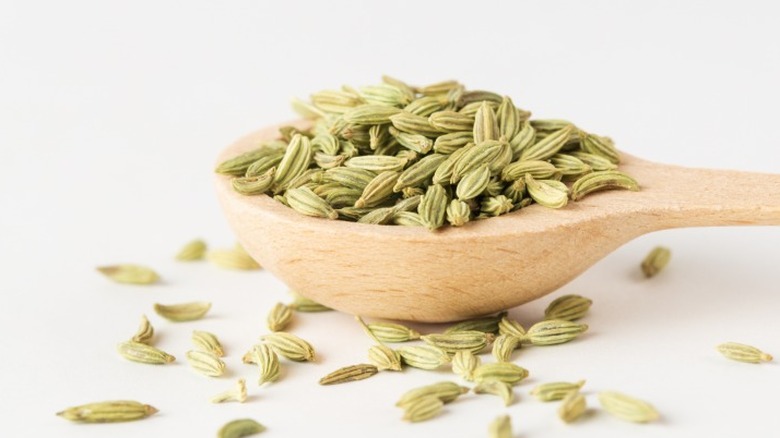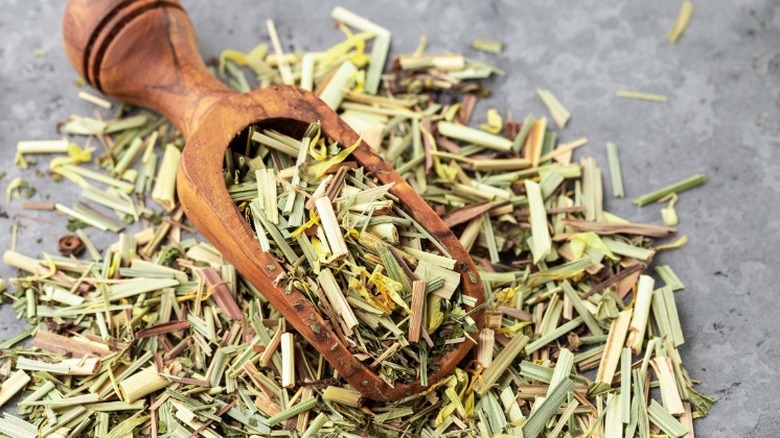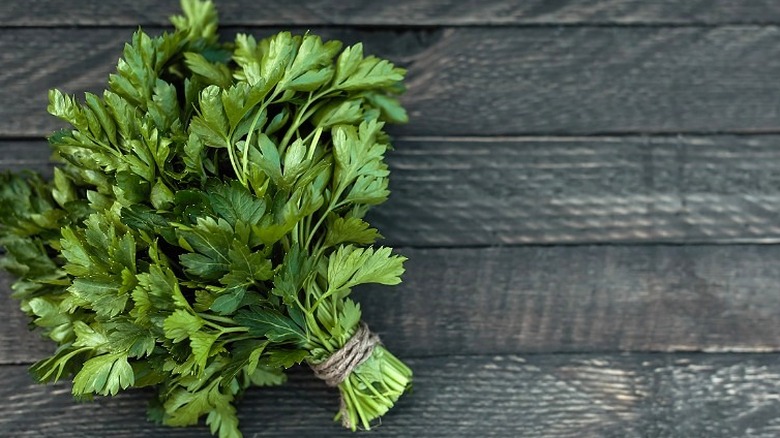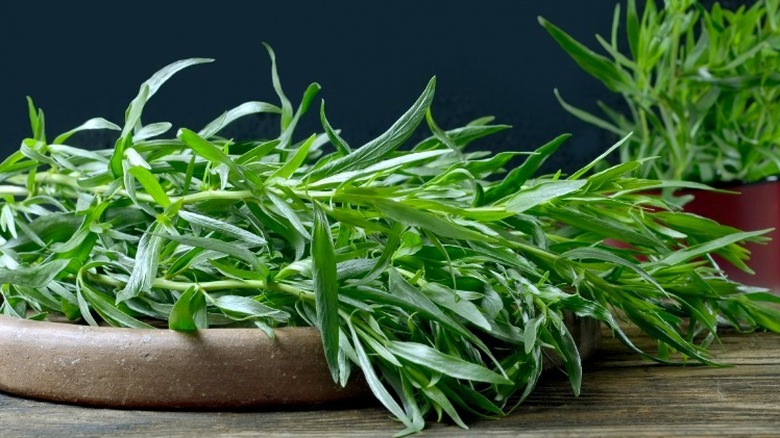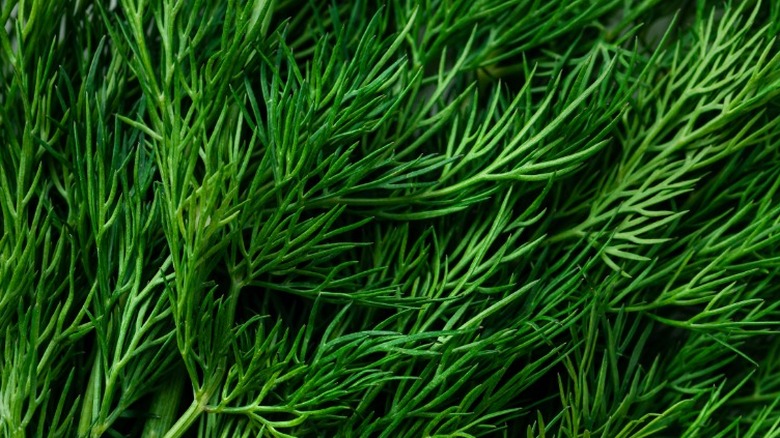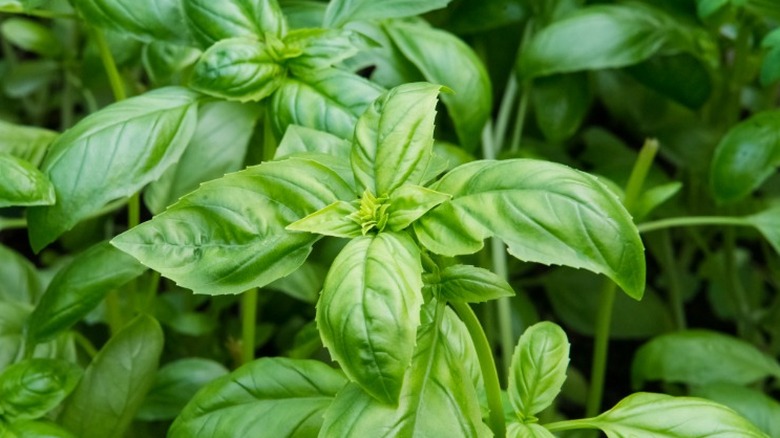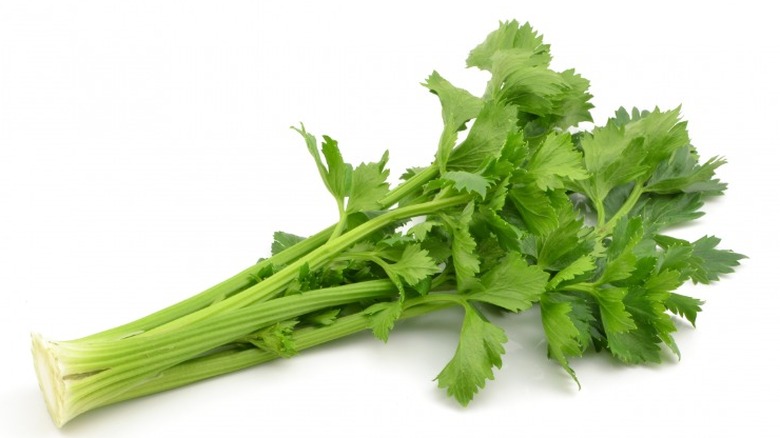The 11 Absolute Best Coriander Substitutes
Coriander is a unique and flavorful herb with a long and storied history. Native to the Mediterranean and North Africa, it was used by the Ancient Egyptians, Greeks, and Romans for its medicinal properties, and it was even mentioned in the Bible (via FoodPrint). But what exactly is coriander? Before we dive in, it's important to make the distinction: coriander is the term for the seeds, while cilantro is used to describe the greens of the same plant, Coriandrum sativum. In some places, the word coriander is used for both. The seeds' flavor is warm, citrusy, nutty, and slightly sweet. It gives a vibrant note and can be used in savory and sweet recipes. The seeds are often used in pickling, baking, stews, and spice mixes.
Cilantro, on the other hand, has to be one of the most polarizing foods. It has a potent flavor similar to parsley, lemon, or soap, depending on who you ask. Those with a distaste for it hate it with a passion. As a result, some top Google searches for the notoriously ubiquitous plant include "why is coriander called the devil's herb," "why is coriander disgusting" and "why is cilantro in everything" right after "why is cilantro so gross." Meanwhile, the reason cilantro tastes like soap to some people is genetic. So whether you're out of coriander or not a fan of its taste on a visceral level, there are plenty of ways to replace it with other herbs and spices in a pinch.
Caraway
Caraway, like coriander, belongs to the Apiaceae plant family, which includes parsley, celery, and fennel. The plant is also believed to have medicinal properties and rivals coriander for the title of Europe's oldest condiment (via NPR). These days, caraway is available in both whole-seed and powdered forms. It provides a nutty, earthy, anise-like flavor to any meal. The seeds are a key ingredient that gives rye bread its unique flavor, but they can also be used in other bread recipes to replace coriander.
When cooking with caraway seeds, it is best to lightly toast them in a dry skillet over medium heat for a few minutes. This will help to release their flavor and aroma. After toasting, whole or crushed caraway seeds can be used in place of the coriander in soups, stews, stir-fries, and salads. Additionally, caraway is a good flavor match for cabbage; you can replace coriander in a sauerkraut recipe. The caraway spice should be used in moderation as it has an intense aroma, so if you're unfamiliar with its full flavor profile, start small and work your way up. Otherwise, you can use the 1:1 ratio when substituting coriander for caraway in a recipe, but remember that the ground spice is more potent than whole seeds.
Cumin
Coriander and cumin are often spotted together in dishes ranging from Indian curries and rice to chili and harissa, but what is the real difference between the two? Cumin is a common fragrant seasoning with Mediterranean and northern African origins. It is related to anise, coriander, dill, and fennel and is sold in whole seed and ground form. It also looks deceptively similar to caraway but has a different color and flavor. Cumin has a prominent role in Indian, Mexican, and Vietnamese cuisine, but it wasn't until the 1960s that it started to gain traction in the United States, thanks to the popularity of Taco Bell (via Spices Inc).
Considering it is one of the most widely consumed seasonings worldwide, and you likely already have it in your kitchen, it makes a great coriander substitute. It has an earthy, nutty, and spicy flavor with slightly bitter undertones and a warm, penetrating aroma with a lemony note. Cumin is a great replacement for coriander in a warming spice bean stew. It also pairs well with lentils, bread, sauerkraut, and veggies such as eggplant, onions, potatoes, and squash. However, as it is a tad more bitter and pungent, it is recommended to start with about ¾ of a teaspoon for every teaspoon of coriander, and work your way up to a 1:1 ratio, if desired.
Curry powder
Curry powder is a common mix of spices used widely in Indian and other South Asian cuisines. While it's been used for at least 4,000 years in its native region, it is believed to have been introduced to Europe by Portuguese colonizers (via Spiceography). Generally, the main ingredients of curry powder include coriander, turmeric, cumin, ginger, fenugreek, cinnamon, and cardamom. Other spices may also be added, depending on the recipe and region. Curry powder is used in soups, stews, marinades, sauces, and of course, curry. Its flavor is slightly sweet and aromatic, with a hint of lemony and herbal notes.
Considering that Indian and other Asian cuisines frequently involve the use of both spices, curry powder substitutes very well for coriander. Curry powder mixes often include coriander and other spices that bring out a more complex flavor. This is a great way to enhance the taste of savory dishes and adds a subtle sweetness that coriander does not have. It is worth noting that using curry powder as a ground coriander substitute may alter the color of the dish as it contains turmeric. If you use curry powder as a replacement, it is best to tread lightly and only use half the coriander powder the recipe calls for. Or, if you're making a vegetable coconut curry that calls for both, you can skip out on coriander entirely.
Garam masala
Garam masala is a well-known Indian spice blend that goes back centuries. Although it bears some resemblance to curry powder, they are not the same. Its name literally translates to "warm spice mix" and refers to the fact that it warms up the body by affecting our metabolism (via NPR). Alternatively, the name is a nod to the preparation process in which the spices used to make this blend are heated before being ground into a powder. The specific ingredients and proportions used to make garam masala can vary from region to region and from cook to cook. A homemade garam masala could consist of whole cloves, anise pods, cumin, cardamom seeds, powdered coriander, cinnamon, and nutmeg. While the blend might be spicy, it is rarely hot, and making your own batch allows you to adjust the flavors to your liking.
Similarly to curry powder, garam masala is often used to flavor curries, stews, and other dishes. However, unlike curry powder, if used as a coriander substitute, it won't change the color of the dish as much due to the lack of turmeric. Nevertheless, it is important to note that making this substitution will usually result in a different flavor profile than using coriander on its own, so use a light hand and watch out for the other spices the recipe calls for to not overdo it.
Fennel
Another member of the Apiaceae family, fennel, has been used since antiquity. It was first cultivated in the Mediterranean and spread across Europe and the Middle East. Fennel was often used in ancient Greek cuisine as a flavoring agent and had a prominent place in mythology, as Prometheus used it to carry the fire from gods to humans (via Nutritional Geography). In addition to its culinary uses, fennel is also used as a breath freshener and as a diuretic (via Respect Food).
Today, fennel is widely used in the kitchen, with its sweet, anise-like flavor being a wonderful addition to many dishes. The whole plant can be eaten: the bulb is often cooked, and the whole and crushed seeds are used as a seasoning. It can be used to make soups, salads, and even desserts. Dried fennel can be used as a coriander substitute, as their complementary flavors are often used in the same dishes. The flavor of ground fennel is subtly sweet, which makes it an ideal addition to a variety of dishes like soups, casseroles, and curries featuring root vegetables. Similarly to coriander, it is often found as an ingredient in bread. Toasted and crushed fennel seeds can be tossed into different dishes like this spiced olive mix, where they are used alongside coriander and can replace at a 1:1 ratio.
Lemongrass
Lemongrass is a fragrant tropical grass native to Southeast Asia, and you should be cooking with lemongrass more often. It has a bright, citrusy aroma and flavor and is a popular ingredient in Southeast Asian curries, soups, stews, and stir-fries. Lemongrass is available in a few different forms: fresh, dried, powdered, and frozen, but generally, the fresh stalks are the most flavorful. With the stalk being quite tough and fibrous, it is better to mince it finely or take it out of the dish before serving.
Lemongrass shares the citrusy, herbal, woody, and floral notes with coriander but is a little more on the sweet yet peppery side. The essential oils in lemongrass are responsible for a distinctive aroma and flavor. To use lemongrass instead of coriander or cilantro in cooking, you'll need to bruise the stalks with a kitchen mallet (or the flat side of a knife) to release the aromatic essential oils. The stalks can then be chopped finely and added to a dish. One stalk of lemongrass can replace 1 tablespoon of chopped cilantro per Clean Eating Kitchen. If using it in a dry rub or marinade, it's best to grind the stalks first.
Parsley
Both lovers and haters of fresh coriander, also known as cilantro, can rely on several other plants when substituting. Cilantro is a family member of parsley, and the two plants bear an undeniable resemblance. It's easy to tell them apart by examining the leaves and stems. Parsley typically has long stems and pointy leaves, whereas cilantro has smoother leaves and is often sold with roots intact. The parsley flavor is sweet and tangy and goes well with lentils, rice, and most vegetables. Its aroma is less sharp and more refreshing than that of cilantro. In addition, its nutritional content is far more impressive, with over five times the amount of vitamin K and almost five times the amount of vitamin C contained in cilantro (via Healthline).
With so many similarities, the two can be used interchangeably in cooking. Compared to cilantro, parsley has a milder flavor that holds up to heat, making it more versatile. You can easily replace cilantro with more parsley in an easy chimichurri recipe that calls for both or turn a cilantro-lime sofrito into a parsley sofrito.
Tarragon
Tarragon, alternatively called estragon, is an herb of European origin. It is a member of the daisy family with a distinct flavor (via Britannica). The three common varieties include French, Russian, and Mexican, with French being the most desirable of the three. Even though it's a staple in French cuisine, it hasn't yet gained much traction in the U.S. So, if this is your first time encountering the herb, you might wonder how to use tarragon. Tarragon is moderately versatile and can be a plausible alternative for those who don't like the taste of cilantro. It has a sweet, anise-like flavor that pairs well with artichokes, zucchini, and potatoes and can be used in various dishes. In France, it is commonly used to flavor fish, poultry, and eggs. It also pairs well with other flavors, such as garlic, onion, and lemon.
When substituting tarragon for cilantro, it is best to use only half the amount the recipe calls for, as tarragon is much more potent than cilantro. There is still a hefty flavor difference between the two, so adding an excessive quantity of tarragon may alter the dish. Its sweet, peppery, licorice-like flavor makes it a great alternative for dishes that use cilantro in small amounts or as a garnish, such as salsas, tacos, and salads.
Dill
Dill is a fragrant herb with a long history. Its use dates back to ancient Greek and Roman civilizations. But while ancient Roman gladiators were rubbing it on themselves to fight inflammation, other, more delicious uses were being found for it around the world (via Britannica). Yet another member of the extended parsley family, dill has bright green, feathery leaves with a mild, slightly sweet, and grassy flavor. Commonly used in Mediterranean and Scandinavian cooking where the seafood is galore, it is also a popular vegetable seasoning in many cuisines.
Cilantro and dill are interchangeable substitutes in some cases, and a similar amount would be needed to make the replacement. Dill can add a subtle sourness that enhances the flavor of the dish. It is commonly used in vegetable-heavy salads, soups, sauces, and pickles and can also garnish dishes. One of its most common flavor pairings is cucumbers, so if you feel adventurous, you could swap it for cilantro in a smashed cucumber salad. If a recipe for a creamy, tangy sauce, dressing, or dip calls for cilantro, be sure that you can replace it with dill. The next time you need a cilantro substitute, don't hesitate to reach for some fresh dill.
Basil
Sometimes referred to as the "king of herbs," basil has been around for millennia and was always revered for its unique flavor that is slightly sweet and peppery. It is common in Italian and Thai cuisines for its robust flavor, and Thailand even has its eponymous variety (via Lacademie). Sweet basil pairs well with corn, tomatoes, white beans, potatoes, garlic, and onion making it a delicate substitute for cilantro in many dishes.
If you're swapping coriander-cilantro because you can't stand its flavor, you're not alone. Ina Garten uses basil to substitute cilantro in chili because she's also not a fan. Basil has a mild and familiar flavor and can be used both fresh and cooked. It works best when added at the end of cooking, as heat can destroy its delicate flavor. For dried coriander, we recommend basil at ⅓ of the amount. Any more will add a significantly different tilt of herbaceous sweetness to your dish.
If you want to maintain the dish's color scheme, go for green basil varieties. The purple ones don't cook well and have a strong clove-like flavor. Basil can replace cilantro in many tomato-focused recipes, such as salsas, guacamole, and curries. And, of course, you can always turn a cilantro pesto into a full-on basil pesto, which will pair well with the warm and comforting flavor of roasted sweet potatoes.
Celery leaves
Those of us familiar with the flavor powers of mirepoix always have some celery, onions, and carrots ready to go. Unfortunately, most recipes tend to work only with the stalks of celery plants, disregarding the flavorsome and highly nutritious celery leaves. These leaves tend to have a moderate piquancy, a fibrous structure, and an earthy and herby taste with hints of saltiness and bitterness (via FoodPrint). Rather than discarding them, purchase celery stalks with leaves intact and use them as a cilantro substitute.
Celery leaves are not commonly used as a flavoring; however, they can be an appropriate substitute for cilantro as they have a milder flavor that may work better in certain recipes. Bearing a visual resemblance to the cilantro leaves, they can also be used to garnish dishes like Cuban black beans, tacos, or burritos. Alternatively, you can replace the ¼ cup of chopped cilantro required in a recipe for a frozen margarita with avocado and cilantro with an equal amount of prepped celery leaves. Its mild, inoffensive flavor will make this drink a blast at the "I Hate Cilantro" party, should you ever host one.
When it comes to coriander as a seasoning, dried celery is also a quality substitute here, though be warned that the essence will be a bit more pungent in overall flavor. For this reason, we typically recommend a less-is-more approach, especially if working with the more common celery salt.

